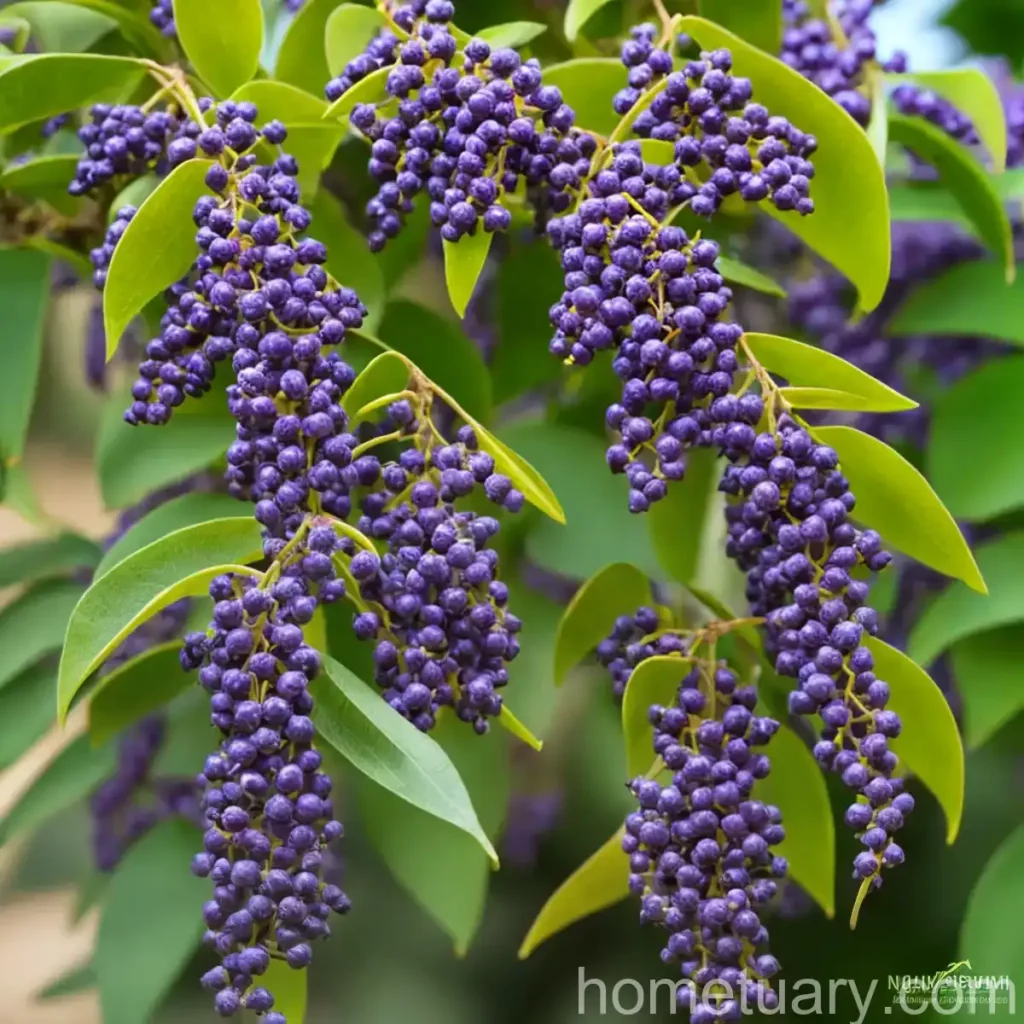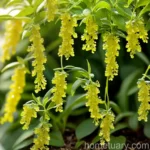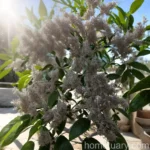Pigeon Berry (Duranta erecta ‘Gold Mound’)
Pigeon berry, scientifically known as Duranta erecta ‘Gold Mound’, is a popular ornamental plant that is cherished by gardeners for its striking golden foliage and delicate, vivid blue flowers. This evergreen shrub is a member of the Verbenaceae family and is native to tropical regions of the Americas. In this comprehensive guide, we will explore the key aspects of caring for the pigeon berry plant, including its cultural requirements, uses, maintenance, common diseases, and more.
Key Takeaways
Below are the key takeaways for the pigeon berry (Duranta erecta ‘Gold Mound’):
- The pigeon berry is widely valued for its vibrant golden foliage and bright blue flowers, making it a popular choice for landscaping and ornamental purposes.
- It thrives in warm climates and requires well-draining soil, ample sunlight, and regular watering to flourish.
- Pigeon berry can be used in gardens, parks, and urban landscaping to add color and vibrancy to outdoor spaces.
- Regular pruning is essential to maintain the shape and health of the plant, and it can be propagated through seeds or cuttings to propagate new plants.
What is Pigeon Berry (Duranta erecta ‘Gold Mound’)?
Pigeon berry, also known as Duranta erecta ‘Gold Mound’, is a versatile and visually appealing shrub that belongs to the genus Duranta. It is valued for its stunning golden foliage and small, tubular, bluish-purple flowers that bloom in pendulous clusters. The plant is native to the Caribbean, Mexico, South America, and the Florida Keys, where it thrives in warm, subtropical climates.
The ‘Gold Mound’ variety is particularly beloved for its radiant golden leaves that bring a splash of color to any landscape. With the right care and conditions, pigeon berry can grow into a dense and lush shrub, adorning gardens, parks, and public spaces with its vibrant presence.
Culture
Uses
Pigeon berry (Duranta erecta ‘Gold Mound’) is primarily used for ornamental purposes, thanks to its striking appearance and easy maintenance. It is a popular choice for landscaping and urban green spaces, where it adds a pop of color and visual interest. The plant’s golden foliage and clusters of delicate blue flowers make it an attractive addition to both residential and commercial landscapes.
In addition to its aesthetic appeal, pigeon berry can also be used as a hedging plant to create natural boundaries and privacy screens. Its dense growth habit and vibrant foliage make it an excellent choice for defining spaces and adding a touch of elegance to outdoor areas.
Water
Proper watering is essential for the health and vitality of pigeon berry plants. While they are fairly drought-tolerant once established, it is important to provide sufficient water, especially during the initial establishment period and in dry spells. Water the plants regularly, allowing the soil to dry slightly between watering sessions to prevent waterlogged conditions.
Sunlight
Pigeon berry thrives in full sunlight and warm, sunny locations. It requires at least 6-8 hours of direct sunlight daily to maintain its vibrant foliage and encourage abundant flowering. When choosing a planting site for pigeon berry, select an area that receives ample sunlight throughout the day to ensure optimal growth and development.
Fertilizer
Applying a balanced, slow-release fertilizer in the spring can provide the necessary nutrients for healthy growth and flowering. Choose a fertilizer specifically formulated for flowering shrubs or ornamental plants and follow the manufacturer’s instructions for application rates. Avoid over-fertilization, as excessive nutrients can cause an imbalance and impact the plant’s overall health.
Soil
Pigeon berry plants prefer well-draining, slightly acidic soil for optimal growth. They are adaptable to a range of soil types as long as the soil is well-draining and provides good aeration to the roots. Amending heavy clay soils with organic matter such as compost or peat moss can improve drainage and create a more hospitable environment for the plant.
Pruning
Regular pruning is essential to maintain the shape, size, and overall health of pigeon berry (Duranta erecta ‘Gold Mound’). Pruning should be done in the late winter or early spring before the plant’s active growth period begins. Remove dead, damaged, or overgrown branches, and shape the plant to promote a tidy and attractive appearance.
When pruning pigeon berry, use sharp and clean pruning tools to make precise cuts and reduce the risk of introducing diseases or causing unnecessary damage to the plant. Additionally, regular pruning can help promote airflow and reduce the risk of pest infestations, contributing to the overall vigor of the plant.
Propagation
Pigeon berry can be propagated through seeds or cuttings, with both methods offering the opportunity to create new plants and expand the presence of this beautiful shrub. When propagating pigeon berry from cuttings, choose healthy, non-flowering stems and root them in a well-draining rooting medium. Provide the appropriate moisture and warmth to encourage root development and subsequent growth.
Alternatively, pigeon berry seeds can be collected from ripe fruits and sown in a suitable growing medium. Keep the seeds consistently moist and provide a warm, well-lit environment to facilitate germination. Once the seedlings have developed sufficiently, they can be transplanted into individual containers or the desired planting location.
Container Popularity
Pigeon berry (Duranta erecta ‘Gold Mound’) is well-suited for container cultivation, making it an excellent choice for urban gardens, patios, and balconies. Its compact growth habit and vibrant foliage make it an attractive addition to container plantings, adding a touch of color and greenery to confined spaces. When growing pigeon berry in containers, ensure that the potting mix is well-draining and provide proper care to accommodate the plant’s needs within the limited space.
Common Diseases
While pigeon berry is generally considered resilient and relatively low-maintenance, it may be susceptible to certain diseases under unfavorable conditions. Understanding the common diseases that can affect pigeon berry plants is essential for proactive management and maintaining their health and vigor.
Disease Diagnosis
Some of the common diseases that can impact pigeon berry (Duranta erecta ‘Gold Mound’) include:
-
Fungal Diseases: Pigeon berry may be susceptible to fungal infections such as powdery mildew and leaf spot diseases. These fungal issues can cause unsightly blemishes on the foliage and impact the overall aesthetic appeal of the plant.
-
Bacterial Diseases: Certain bacterial pathogens can lead to diseases like bacterial leaf spot, affecting the health and vigor of the plant. Bacterial infections can manifest as dark spots or lesions on the leaves and stems, potentially leading to defoliation and reduced growth.
-
Viral Diseases: While less common, viral diseases can also affect pigeon berry plants, causing symptoms such as yellowing, mottling, and distortion of the foliage. Viral infections can weaken the plant and reduce its overall performance.
Common Pests
In addition to diseases, pigeon berry may also encounter certain pests that can pose a threat to its well-being. Common pests that may affect pigeon berry (Duranta erecta ‘Gold Mound’) include:
-
Aphids: These small, sap-feeding insects can congregate on the tender new growth of pigeon berry, causing distortion and discoloration of the foliage. Severe infestations can weaken the plant and impede its growth.
-
Whiteflies: Whiteflies are tiny, white, winged insects that can cluster on the undersides of leaves, feeding on the plant’s sap and potentially transmitting viral diseases. Infested plants may exhibit yellowing and wilting of the foliage.
-
Spider Mites: These arachnids can infest pigeon berry plants, causing stippling, discoloration, and webbing on the leaves. Spider mite infestations can weaken the plant and affect its overall appearance.
-
Caterpillars: Certain caterpillar species may feed on the foliage of pigeon berry, leading to visible defoliation and damage to the plant. Regular monitoring and early intervention can help manage caterpillar infestations effectively.
Botanist’s Tips
To ensure the successful cultivation and maintenance of pigeon berry (Duranta erecta ‘Gold Mound’), consider the following botanist’s tips:
-
Selecting the Planting Site: Choose a well-drained location with ample sunlight for planting pigeon berry, ensuring that the site can accommodate the plant’s growth habit and sun exposure requirements.
-
Watering Practices: Provide consistent watering, especially during periods of dry weather and the initial establishment phase. Avoid overwatering to prevent waterlogged conditions and root rot.
-
Pruning Techniques: Practice regular pruning to shape the plant, remove dead or damaged branches, and maintain its overall health and appearance.
-
Monitoring for Pests and Diseases: Routinely inspect the plant for signs of pest infestations and diseases, taking proactive measures to address any issues and prevent their spread.
-
Selective Propagation: When propagating pigeon berry, select healthy and vigorous parent plants to ensure the successful establishment of new specimens.
Fun Facts
Here are some interesting and fun facts about pigeon berry (Duranta erecta ‘Gold Mound’):
-
The distinctive golden foliage of the ‘Gold Mound’ variety makes pigeon berry an eye-catching addition to gardens and landscapes, adding a touch of brightness and color.
-
Pigeon berry is known for attracting butterflies, bees, and other pollinators with its nectar-rich flowers, contributing to garden biodiversity and ecology.
-
The plant’s small, berry-like fruits are attractive to birds, adding to its ecological value as a potential food source for wildlife.
-
Pigeon berry is celebrated for its resilience and adaptability, making it a popular choice for gardens in warm and subtropical regions.
-
The striking combination of golden leaves and blue flowers makes pigeon berry a versatile and visually appealing plant for various ornamental purposes.
Links to External Resources
For additional information and resources about pigeon berry (Duranta erecta ‘Gold Mound’), consider exploring the following links:
- RHS Gardening – Duranta
- University of Florida IFAS Extension – Pigeon Berry
- Missouri Botanical Garden – Duranta erecta
In conclusion, pigeon berry (Duranta erecta ‘Gold Mound’) stands out as a captivating and versatile shrub with its vibrant foliage, delicate flowers, and ecological contributions. With proper care and attention to its cultural requirements, pigeon berry can thrive in gardens, public spaces, and container plantings, offering a visual treat and ecological benefits for both gardeners and wildlife. Whether used for ornamental purposes, hedging, or attracting pollinators, pigeon berry embodies the charm and resilience of a cherished garden plant.















